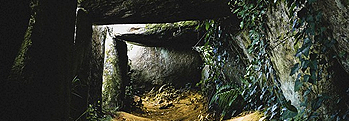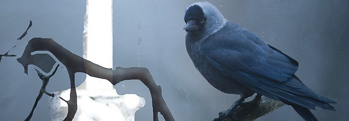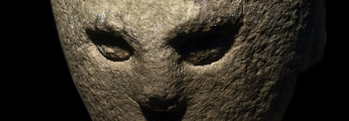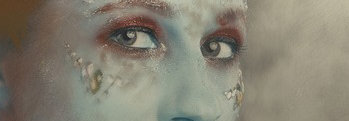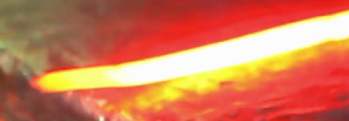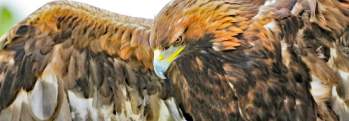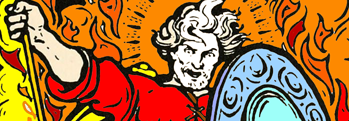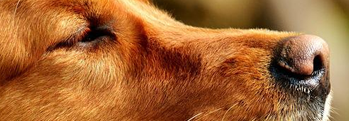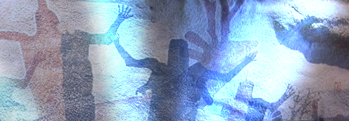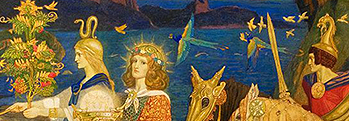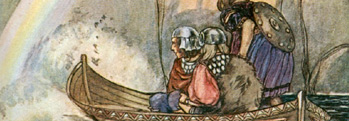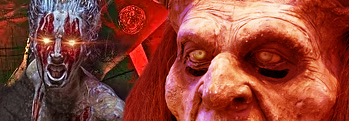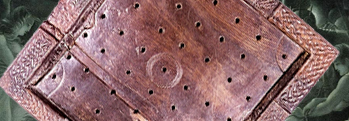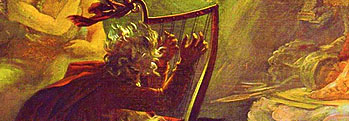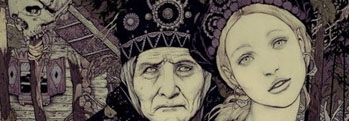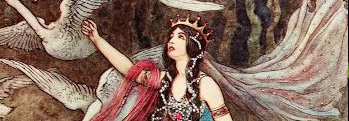The Speech of Severed Heads and Gaelic Necromancy
Irish and Celtic myths and legends, Irish folklore and Irish fairy tales from the Mythological Cycle
When staying one step ahead of the rest took on a new meaning
The Tuatha De Danans
By the force of potent spells and wicked magic,
And conjurations horrible to hear,
Could set the ministers of hell at work,
And raise a slaughtered army from the earth,
And make them live, and breathe, and fight again.
 So it was written in Keating's General History of Ireland, considered by many to be the definitive work bridging the Ireland of the ancient world with the Ireland of the modern world. He was working from texts we no longer possess and know only by reference, but there are still sections of the Lebor Gabála (the Book of Invasions, a very ancient tome) which tell of the occult necromantic skills of the Tuatha.
So it was written in Keating's General History of Ireland, considered by many to be the definitive work bridging the Ireland of the ancient world with the Ireland of the modern world. He was working from texts we no longer possess and know only by reference, but there are still sections of the Lebor Gabála (the Book of Invasions, a very ancient tome) which tell of the occult necromantic skills of the Tuatha.
From the time before the flood, when the dread wizards recalled by Enoch walked the land, when vast tablets of ice had buried half the world beneath gloomy fathoms of imponderable weight, when there were still dragons, wyrms steeped in wickedness, feasting on the nations of the earth, came the sorcery of the Tuatha Dé Danann.
The knowledge of these last vestiges of an elder age was passed on in secret to the druids of the Milesians when they came, especially the likes of Mogh Ruith who studied beneath the Sidh, in the dark underworld the Tuatha Dé Danann had retreated to. This they added to the wisdom of the Fomorians brought forth from the grey-wracked ocean by rare travellers of that race, and become known across the realms for their power and wisdom.
Very often their rites and rituals centred around the head, where they believed the soul was seated. This was also reflected in cultures across the isles and the continent, with the Greeks recording that the Celts would have strings of severed heads hanging from the bridles of their horses. Later, they would be displayed around their homes, or embalmed in cedar oil and stored in a chest as war trophies. The Romans were also greatly disturbed by this habit, although they were not averse to taking a few heads themselves!
However the manner in which the rich and varied tapestry of peoples who were later called the Celts took and preserved heads was quite different from the vengeful example-making of the Romans.
Noted was their habit of taking the heads of their most honoured friends and leaders, in some cases defleshing them and in others preserving them with oils and ointments, decorating them with jewels and golden plates, and keeping them in honoured positions of prominence. They might take the head of one of their allies in case it fell into the wrong hands. There may also have been a belief that you could influence a person's afterlife by the use of their head.
On the continent, temples have been found with niches for the most important heads to be placed, and human skulls were nailed over doorways and gates in farms and fortresses. Carven mouthless stone heads with closed eyes are found all over Ireland and Scotland, symbolising the dead.
Decorated skulls would have been used by the druids for drinking from their sacred springs and wells during their rituals, a tradition which is still spoken of – although not practised – near some holy wells in Ireland. This may also have been associated with the cult of Crom Cruach, which some have translated as “Ceann Cruaigh” or the bloody head.
Recent scientific examination has demonstrated that the cut and scrape marks created by the defleshing of the dead by Gaelic peoples are quite different from bones butchered for meat. Evidence for defleshing seems to go as far back as the mid to Upper Palaeolithic, about 27,000 years ago, when individual skulls were heavily ochred and separately buried. This defleshing took place possibly after a period of excarnation, and prior to burial.
Cú Chulainn is said to have come back from his first battle with quite an array of severed heads, three attached to his chariot, nine in one hand and ten in the other, and no one was more impressed than his wife, Emer.
In the epic The Táín Bó Cualinge after cutting off twelve of his opponents' heads, Cú Chulainn planted twelve stones for them in the ground and set a head on each stone. In the story of Garb of Glen Rigel, Cú Chulainn met the two-headed Garb in single combat. He cut Garb's double head from his neck and impaled it upon a stake.
But as strange and macabre as that might seem to us, it was nothing compared to what the heads used to do after being severed – for many are the tales that tell of heads continuing to speak, offering advice, giving orders, reciting poetry and more, long after being removed from their bodies!
Severed heads were valued for their association with divination and the supernatural, offering protection from malevolent spirits. Often enough a head taken in battle might be brought to a celebratory feast where food and drink were offered to it, and the head in turn might tell a story. Sometimes heads didn't wait that long, and would give orders on the battlefield where it had been slain.
These heads may have also served as gatekeepers and bridges into the Otherworld, transporting whole groups of people to strange places and times.
In the Táin the hero Sualtam is sent to awaken the men of Ulster to fight against invading forces, but in a freak accident, the sudden jumping of his horse causes his shield to slide, slicing his head clean off. His head continues to call for the Ulstermen’s assistance, however, and it is this which finally brings them to the aid of Cú Chulainn.
In the story of the Destruction of Da Derga’s Hostel, Conaire Mór, famed king of Ireland, was attacked. After slaying many enemies, he asked his champion, Mac Cécht, to bring him some water. As the warrior returns with the drink, he sees two men lop off Conaire’s head, and enraged, he kills them both. Conaire’s head carries on talking, drinks the water, and composes a poem in honour of Mac Cécht’s loyalty and prowess, which all things considered was impressive.
The head would thereafter speak when water from a sacred well was poured upon it.
In the Battle of Allen or the Cath Almaine, preserved in the 11th-century Yellow Book of Lecan, the men of Leinster fight against Fergal Mac Maile Duin, who is slain.
Fergal is beheaded and his head is taken to King Cathal who honours it, washes it and braids and combs smooth its hair, wraps a cloth of silk about it, and places seven oxen, seven wethers and seven cooked pigs before Fergal's head.
From the same book comes the tale of the Head of Donn Bó, a young man famed for his sweet singing who was slain at the battle and decapitated. Donn Bó had promised to sing that night for his lord Fergal no matter where they should be. One of the victorious called Baethgelach went onto the battlefield in order to take a head back to the feasting-place as a trophy.
As he approached, he heard the severed head entertaining the dead king’s body on the field. The voice of Donn Bó was sweeter than the voice of any other head, or so the story goes. When the warrior approached to lift his head, the head stops him and says it is pledged to sing for Fergal alone that night.
Nevertheless he lifted the head, and taking it back to the building, placed it on a pillar. It is asked to sing, wherein it turned its face to the wall so that it was in darkness and sang so sweetly that all wept. It was finally taken back to the battlefield, where it was magically rejoined with its body.
A mighty warrior called Fothad Canainne never sat down to a feast without decapitated heads before him, and in turn Fothad's severed head sings a long poem to Ailill's wife after she lifts it up.
Then there was Fothad Canainne, not the first man to lose his head over a woman but one of the few to tell about it afterwards! He was chieftain of the Connacht branch of the Fianna who fell in love with the wife of the leader of the Munster Fianna. They eloped, but her husband came after them with his men. Nearly all of them were killed in the ensuing scrap, and the poor woman, finding her lover’s severed head, picked it up and carried it to where his body lay. Fothad’s head then spoke to her, leaving her with a verse in memory of his life and tragic ending.
Fionn of the Fianna was not unfamiliar with talking conversational heads either, for when his favourite fool Lomna was killed upon witnessing his wife’s adultery, Fionn found the headless body and followed it to the house of the murderer. Within there was none other than Lomna’s head beside the fire, but when the murderer Coirpre doesn’t feed it any fish three times, Lomna’s head decides to tell the whole tale, but in riddles. So much did it talk that Coirpre eventually had to put it outside like a misbehaving dog, where it still refused to shut up!
There are many more such tales in Welsh and Scottish folklore, and even in pre-Roman British legends, such as The Assembly of the Wondrous Head where King Bran, having been mortally wounded in the foot with a poisoned spear, ordered his head to be cut off by his own men. The head kept talking and as good company as it ever was until it was buried.
And even more can be found, including the making of brain-balls of lime and… the brains of enemies… to be cast from slings. One such, called the Tathlum, was used by the Dé Danann lord Lugh to slay Balor of the evil eye, and the recipe for this is given as follows:
A tathlum, heavy, fiery, firm,
Which the Tuatha Dé Danann had with them,
It was that broke the fierce Balor's eye,
Of old, in the battle of the great armies.
The blood of toads and furious bears,
And the blood of the noble lion,
The blood of vipers and of Osmuinn's trunks
It was of these the tathlum was composed.
The sand of the swift Armorian sea,
And the sand of the teeming Red Sea
All these, being first purified, were used
In the composition of the tathlum.
Briun, the son of Bethar, no mean warrior,
Who on the ocean's eastern border reigned
It was he that fused, and smoothly formed,
It was he that fashioned the tathlum.
To the hero Lugh was given
This concrete ball, no soft missile
In Mag Tuireadh of shrieking wails,
From his hand he threw the tathlum.
Peculiar tales persist about these traditional beliefs lasting even into recent times, such as that of a young man who travelled to Antrim in the 1940s for work. When there, he fell ill, but before he died asked that his friend cut off his head and carry it to his home village, where it can be buried with his own people.
The friend duly returned the severed head to its home village, and the rest of the story tells how, as the funeral procession is approaching the graveyard, they saw another procession coming and – as was the custom, the story says – the funeral parties raced to see which would have the honour of holding their ceremony first. The other party won but, as it reached the graveyard wall, it vanished.
And then of course we have the Irish custom of carving turnips into heads, and even letting them dry year on year to give them a more wizened and wrinkled appearance, to be lit with candles on Hallowe’en, the time of the dead!
Strange and ancient are the ways of Ireland.
Da Dearga’s hostel was rumoured to be near the spot marked on the map below!
More Stories from the Mythological Cycle
The Irish love music, and it has long been said that the Irish race lived and breathed melodies, liable to burst into song at the drop of a hat. Few realise how far back the Irish musical tradition goes however - at least as far as we know! Some of the earliest musical instruments which have been uncovered date from the Irish Bronze Age, in thos ... [more]
During the Irish bronze age, the working of gold reached heights never before seen or dreamed of. Goldsmiths fashioned the soft, luminous metal into intricate forms resembling cloth, cord, the rising and falling hills of Ireland, and many other striking designs. Among their most famous and beautiful creations were the astonishing gold collars, one ... [more]
The warm, glimmering golden glow of amber, or ómra in Irish, has held deep fascination for people since the Neolithic and probably long before that. Its rich, flowing contours capture and refract the sun and firelight with equal facility, and it may have been one of the first gems worked by human hands. Its beauty has inspired enterprise and ... [more]
This stunning battle-shield, cast from golden-hued shimmering bronze, was originally made during the bronze age. It is one of about two dozen similar shields of varying sizes found across the Irish Isles, and dates back to around 1000 BC. Measuring around 71cm across, it began life as a flat sheet of bronze, which was then hammered over rounded ... [more]
The extraordinary bronze age Irish axehead is remarkable not only for the decorations adorning the axe itself, but also for the carry-pouch or sheath discovered along with it when it was found four meters deep in a peat bog in Brockagh, County Kildare. It is very unusual for any organic material to have survived thousands of years, but the unique c ... [more]
The Lurgan Canoe is one of the earliest boats found in Ireland, dating back four and a half thousand years, made from a single mighty oak tree felled when the first metalworkers began to arrive. This was a time of upheaval, mystery, magic, and wonder, old orders tottering and collapsing, the end of the age of the God-Kings of Ireland with their pon ... [more]
We are delighted to be able to present to you the rules of Fidchell, the Irish game of kings! This game can be purchased, but it's easy to get started and try it out for yourself. All you need is a 7 x 7 board, which can be squares or pins marked out - even on paper - 16 white or attacker pieces, a king piece, and 8 darker-coloured defender pie ... [more]
Times were hard in Ireland not so long ago, and harder yet they were before that – many’s the family was cast out of their houses for being unable to pay their rent! One such was poor Finian O’Toole, the kindly father of nine children who found himself evicted by the cruel English landlord in the parish of Kilmoe. Now it was th ... [more]
There is a tale, one of the oldest stories among the many very ancient stories of Ireland, of a man who returned to life as a man thousands of years after he first walked the earth. His legend was found in an eleventh century manuscript called Lebor na hUidre, which means The Book of Dun Cow, and it was written there by the followers of an early ... [more]
It’s a not uncommon belief that the women of Ireland in the ancient days were quiet and kept to themselves, letting the men do all the great deeds and win all the fame – but nothing could be further from the truth! From that day to this Irish women were and remain wild and fearless, willing to go to lengths as great as any man for victo ... [more]
Of great renown are the feats and deeds of the ancient heroes of Ireland, and still to this day they echo through our legends where such tales are told. But of scarce less fame were the weapons they bore, implements of glory and terror, bound to ancient spirits and clasping lightning within their shimmering length, wielded with scarcely imaginable ... [more]
The Tuatha De Danans By the force of potent spells and wicked magic, And conjurations horrible to hear, Could set the ministers of hell at work, And raise a slaughtered army from the earth, And make them live, and breathe, and fight again. So it was written in Keating's General History of Ireland, considered by many to be the definitive ... [more]
Her name was Clíona or Clíodhna and she was one of the most beautiful women of the Tuatha Dé Danann, that vanished sorcerous race whose legends echo still from one end of Ireland to the other. Some even say she was the most beautiful woman in the world, and she was worshipped as a goddess by the pagans of Ireland who followed t ... [more]
Many are the tales told of Lugh, the mightiest king of that ancient and mystical sorcerer race of Ireland, the Tuatha Dé Danann, but only one is told of his death. Now Lugh, lord of many warriors, had four wives, which back in those days wasn’t too unusual, and their names were Echtach, daughter of white-toothed Dagda, Englec, Ná ... [more]
Just as happens today, people in ancient Ireland had legal disputes and complaints they would bring before their courts, and the judge or king would try to make sense of what had happened and hand down a fair decision. But also just as happens today, there were situations where it was one person’s word against another, or there wasn’ ... [more]
The old stories of Ireland, some of the oldest in the world, tell of great ancients – almost immortals! – whose span of life stretched many thousands of years. Legends tell of their spirits passing from one body to the next, or upon occasion, staying in the one body for millennia, watching the tides of man and beast come and go. Such ... [more]
One of the chiefest and most powerful kings among the mystical Tuatha Dé Dannan was the one called Dagda, or Dagda Mór, which means “of shining skills”. He had other names too, such as Eochu the horseman, Ruad Rofhessa, lord of great knowledge, Dáire the fertile one and Aed, he of the fiery temper. Others yet called ... [more]
The Irish Brehon law codes are said to be the earliest fully developed legal system in Europe, but long before the Brehons were laid down there were earlier laws and all were subject to them, from the lowest to the highest! Women could hold their own property, were not themselves considered property, and could seek an education and improve their ... [more]
No tale of ancient Ireland could be complete without mentioning the Fomorians, dreaded foes of the Tuatha Dé Danann and all who came to conquer Ireland. The meaning of their name is debated even today, although most agree that the first part, fó, means “from below” or “nether” and the latter part means “t ... [more]
Many of the oldest records of Irish mythology and legend, which you might truthfully say are a history of prehistory, tell that the first people to arrive in Ireland were led by the lady Cessair when she fled to this land to escape the coming flood. The idols which had whispered through veils of midnight smoke that Ireland was a land untouched by p ... [more]
Throughout the old stories of Ireland are scattered mentions, and sometimes even descriptions, of some of the spells and rites used by both the Tuatha Dé Danann and those who came after them, the Gaels or Milesians, as they are sometimes known. Tales of these wondrous and mysterious feats of sorcerous skill may seem strange to us, but to the ... [more]
It was a warm and balmy summer's night, heavy with the fragrances of heather and honeysuckle, when Aengus, son of Dagda, awoke to find a beautiful young woman approaching him where he had slept. He was immediately taken with her grace and elegance, and his heart yearned for her, but when he tried to speak, she vanished! He stayed in his bed ... [more]
The river Barrow, like many rivers in Ireland, was given its name in ancient times. Few now know it once had another and very different name however, for it was when Dian Cécht walked the world, the healer of the Tuatha De Danann, that this river was first named! Dian Cécht, whose name meant swift power or swift potion, depending o ... [more]
A thousand years before the Olympic games were founded, the Tuatha De Dannan had arrived in Ireland and defeated the Fir Bolg, establishing their place on the Emerald Isle. The mighty queen Tailtiu had married Eochaid mac Eirc of the Fir Bolg, but he was killed during the invasion of Ireland by the Tuatha, so the leader of the invaders took her for ... [more]
In ancient times the Gaels would hold great festivals at different seasons of the year, such as the Tailteann Games, Tlachtga, Raigne and Lughnasadh, and it was at the beginning of August, every three years, that the festival of Carmun would be held during the festival of Lugh. Mighty were the celebrations held, with the racing of horses and the ... [more]
Long ago it was the time of the Tuatha De Danann in Ireland, and they were troubled by strife from beyond the Emerald Isle and within it. One of their mightiest warriors whose name was Lugh of the Long Hand heard that their demonic enemies from the sea, the Fomorians, had landed at Eas Dara, so he hopped up on Aonbharr, a horse which could gallop a ... [more]
Some of the most ancient Irish myths and legends tell of the Bocanachs and the Bananachs, known to the people of Ireland as fierce spirits of the air that were drawn to scenes of battle and bloodshed. Whenever armies gathered to test their might, the sky overhead would be filled with shrieking demons dancing to the sounds of swords clashing and blo ... [more]
Woven through many Irish stories, myths and legends is the ancient game of Fidchell, which means “wisdom of the wood”. It's said that it was invented by none other than Lugh of the Tuatha De Dannan, and predates chess by many centuries. Fidchell held a central role in the celebrations of Lugh, and at Samhain festivities as well, ... [more]
Well known is the ancient tale of the Children of Lir, and how two of the three of Bodb Dearg's daughters by Oilell of Aran married Lir to keep the peace in Ireland, between the rival chieftains of the Tuatha De Dannan. But less well known perhaps is the story of the daughter of the Bodb and one of her admirers, Cliach the Harpist. Cliach pl ... [more]
After the second battle of Moy Tura, Nuada the High King of the Tuatha De Danann was grievously injured, and as it was the law among their people that a king must be whole of body, Dagda Mór took his place. Mighty Dagda, of whom the ballads are sung, he was called the father of the Tuatha, the lord of knowledge, the many-skilled, th ... [more]
It is in the nature of fairytales and legends passed down from generation to generation that they might sometimes change and shift to fit the lives of the people of the time, and the more mysterious the figure the more legends accrue to it! And so it is with Donn of the Dead, king of the dead at the red tower of the dead, whose three sons cried &ld ... [more]
It was at the dawning of the world when the fair folk walked in broad daylight as bold as you and I, before the coming of the Milesians with their bitter iron blades and earthen ways, it was the time when magic was wrought and druidry had power, when heroes gave battle to gods and the titanic children of Seth still troubled the dreams of Heaven, it ... [more]
The raven has long been an omen of ill-tidings around the world, bearer of bad news and warnings, but in Ireland it was known once as a servant of the fairy Morrigan, or the raven was herself in person! She it was whose name meant the Great or Ghost Queen, from the old words for fear and greatness. Some will tell you earnestly that she was a god ... [more]
Long ago, in the time of the Tuatha Dé Dannan, one of their number became the high king of all Ireland, and his name was Eochaid Ollathair. He was a powerful magician of that sorcerous race, and by his workings he could change the weather and ensure the harvest was plentiful, as well as many other things. His wealth was vast and he was mu ... [more]
It was in the time of legends and heroes, when the Tuatha Dé Dannan had determined to go into their deep halls beneath the hills and mountains of Éireann the green, that the Dagda mór had fallen at the second battle of Moy Tura. With his slaying a new leader had to be elected and that was decided by the Tuatha to be the Red Cro ... [more]
And so it was when dragons still flew and champions walked the earth that the men of the Fir Bolg had lordship over all of Ireland. They had left Ireland centuries before due to the violence and heavy tribute demanded by the Fomorians, travelling far and wide until they came to the distant land of Greece. Although they made agreement and treaty ... [more]













